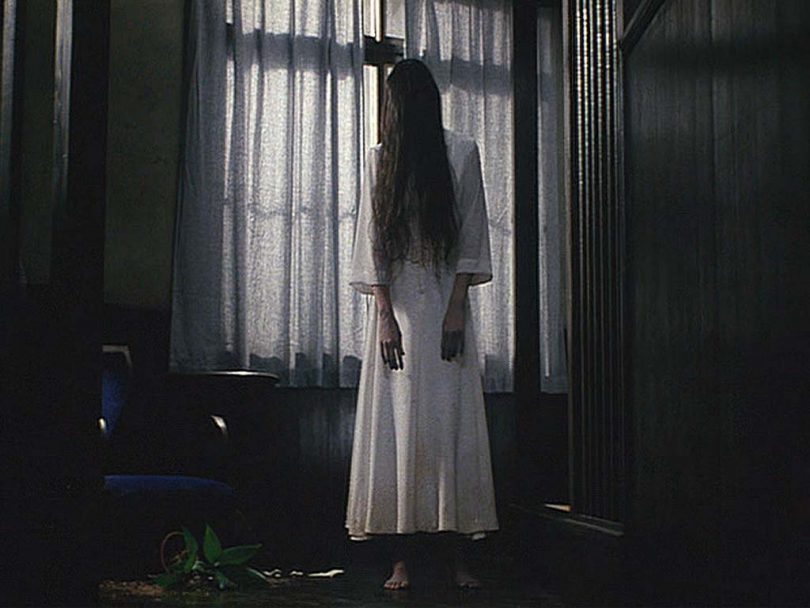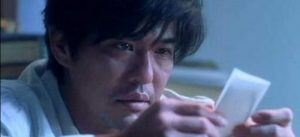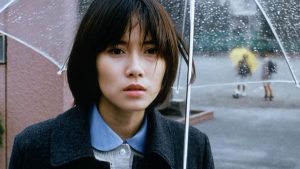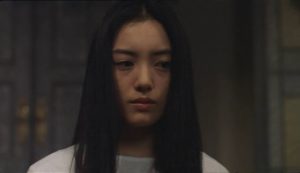If there was ever a film series that defined the Japanese horror genre, it must be Ring. Based on the best-selling novels by Koji Suzuki, Ring has been frightening and fascinating audiences through its iconic cursed videotape and ghastly ghoul Sadako Yamamura. The release of Ring in 1998 introduced western audiences to Asian horror, garnering much interest, and a slew of American remakes of such movies.
Suzuki’s novels consist of Ring, Spiral, and Loop, a short story collection Birthday, and two sequels S and Tide. There have been numerous adaptations into films and television in Japan, South Korea, and America. For the Halloween season this year, I am going to delve down the well and review every single major adaptation of Ring. We will split this retrospective into three parts: The first focusing on the original film series, the second on other sequels, spin-offs, and Asian adaptations, and finally the third will study the American remakes.
Ring (1998)
Our journey begins with Ring, not the first adaptation, but certainly the most prominent. The film was directed by Hideo Nakata, who would also direct Ring 2 and the other Suzuki adaptation Dark Water. Liberties are taken with the novel, such as changing the protagonist’s gender, and Sadako’s curse from a mutated smallpox virus into a more traditional death curse. With only a budget of about 1.2 million dollars, Nakata does an excellent job of crafting an atmospheric film that feels tense, eerie, and even claustrophobic at times. This is supported by the stellar cast, strong screenplay, and unsettling score composed by Kenji Kawai.
The movie follow Reiko Asakawa (Nanako Matsushima), a hardworking journalist who investigates the unusual death of her niece Tomoko, connecting her disturbing demise to the urban legend of a cursed videotape. Tracking the tape down to a holiday resort in the Izu province, Reiko discovers it is very real, containing a series of abstract but haunting imagery. Moments later, a telephone rings, cryptically warning Reiko she has seven days until she dies. Reiko teams up with her amicable ex-husband Ryuji Takayama (Hiroyuki Sanada) to solve the origins of the curse. This becomes even more urgent when their young son Yoichi (Rikiya Otaka) watches the tape himself.
The film carries themes of a societal clash between tradition and modernity, and a phobia of technology, personified through the videotape and Sadako, who resembles the classic physique of vengeful yūrei. Supposedly, audiences were so terrified of Ring, that they hid or removed their personal televisions from their homes.
This theme also continues into then-traditional family roles, which is mirrored between the Asakawa and Yamamura families. Reiko develops her own independent role as a career woman, but has a distant relationship with Yoichi. This gradually changes over the course of the film, with both Reiko and Ryuji going to great lengths to avert their own deaths for Yoichi’s sake. Contrariwise, Sadako faced harm from her family: exploited by her uncle, abandoned by her mother who killed herself, and ultimately thrown down a well by her father.
In terms of frights, they are presented through a slow build up, without relying on gore and jump scares to stimulate the audience. The videotape’s imagery was shot using a 35 mm film, then digitally enhanced to give it a more authentic look. Of course, the most iconic scene is Sadako crawling out of the TV to kill Ryuji. To achieve this, Sadako’s actress Rie Ino, a kabuki performer, walked backwards in a disjointed manner. The footage was then reversed to portray Sadako’s unnatural movements. We do not see Sadako’s face under her dark hair beyond a furious eye, which is enough to scare characters to death.
The film does an effective job of portraying Sadako as a sympathetic villain, only to blindside us with the truth of her character – she wants the whole world to suffer as she has. Reiko learns she was spared by copying the tape and showing it to someone else, spreading it like a virus, thus creating an endless ring that could never end. In the final shot of the film, Reiko races away to save Yoichi as dark clouds roll over, directly referencing ending of The Terminator, suggesting either hope or despair lie ahead. The same could be said for Ring’s following instalments.
Spiral / Rasen (1998)
It is not often that a film’s sequel is released in the same year, let alone at the exact same time. Spiral (better known as Rasen) is an adaptation of Koji Suzuki’s second novel, being the original sequel to Ring. Asmik Ace Entertainment, the films’ production company, made the sequel to draw audiences back in quickly and rake in some more cash. Becoming a box office bomb due to low audiences and poor reviews, Spiral was quickly retconned by the studio, becoming the lost sequel. Most of the original crew returned, though the film was directed and written by Jōji Iida.
Spiral lacks the supernatural tone of the first film, instead being more of a medical mystery drama. It is much closer to Suzuki’s novels, introducing science fiction elements to explain the true nature of Sadako’s curse and goals. It is an essential part of Ring, despite being a mostly forgettable movie. Aside from the game-changing plot twist in the third act, the whole film drags, plagued by stiff acting and an emotional disconnect from the characters.
Mitsuo Ando (Kōichi Satō) is a pathologist grieving his late son Takanori after he drowned two years prior. Ando and his colleague Miyashita (Shingo Tsurumi) learn they are to perform the autopsy on their friend Ryuji Takayama. They discover Ryuji died of heart failure, find what resembles a smallpox tumour, and a handwritten message in his stomach that is in a cipher code. Ando learns of Ryuji’s mysterious death, meeting his student Mai Takano (Miki Nakatani), who tells him about the cursed videotape. Mai appeared in Ring, having found Ryuji’s body.
Ando uncovers the events of the first film, culminating in the news that Reiko and Yoichi died offscreen in a car crash – with the police suspecting Yoichi died in the same manner as his father Ryuji. It is only after watching a copy of the tape does Ando become a believer, searching for a connection between the supernatural and scientific. He assumes Ryuji’s last wish is for him to destroy the tape for good, willing to perform a heroic sacrifice to atone for Takanori’s death.
It is in the third act that things get wild. Ando and Mai sleep together, only for the latter to disappear for a few days, then reappears later in summery dresses and being very flirtatious. That is until the police find a dead body stuffed into a vent – belonging to Mai. Ando realises that Sadako has been resurrected, played by a lively Hinako Saeki. Her plan was to use the curse to be reborn, actually a mutant smallpox strand that can clone the deceased via intercourse. She has already done the same to Ryuji, who is in league with her for some reason. Sadako than offers to resurrect Takanori in exchange for unleashing the curse upon humanity, allowing Ando happiness at the expense of mankind. It is certainly a harrowing, apocalyptic end, but feels like it should have been in a much better movie.
The film as a whole is underwhelming and dull, which is a shame, considering how Spiral took the story is a game changing direction. Spiral was swept under the rug, replaced with Ring 2, with Hideo Nakata returning to direct.
Ring 2 (1999)
Ring 2 continues directly after Ring, doing away with the more radical story twists of Spiral for a more mundane plot. The supporting characters of the first film take centre stage as they both deal and learn of the cursed videotape. It feels like the movie will up the stakes, especially with the revelation that the tape must be spread in order to escape death. Instead, the film remains rather self-contained in its storytelling.
Following Ryuji’s death, Mai Takano searches for answers, aided by Reiko’s colleague Okazaki (Yūrei Yanagi). They learn that Reiko’s father had died after watching the tape, whilst Reiko and Yoichi have vanished. Mai eventually crosses paths with the Asakawas, learning Yoichi’s psychic powers have turned volatile under Sadako’s influence. Dr. Kawajiri (Fumiyo Kohinata), an eccentric scientist, presents a method of neutralising psychic energy by exorcising it through water.
Okazaki, still hoping to get a story, contacts high school student Kanae Sawaguchi (Kyoko Fukada) who watches the tape. Okazaki promises to save her, but chickens out and hides the tape. When Kanae dies, Mai has to give Reiko up to the police. Fearing that Yoichi will be vilified like Sadako, Reiko tries to flee, only to hit by a truck. Mai, Yoichi, and Dr. Kawajiri head to Sadako’s home on Oshima Island to end her terror for good. Sadako’s uncle Takashi (Yoichi Numata) collects Sadako’s body, learning from the police that she was actually alive in the well for thirty years. Takashi, whose actions had destroyed his family, tries to give Sadako a burial at sea, before aiding Mai and Kawajiri in the third act.
As for Okazaki, he gets quite the comeuppance. His attempt to delete an interview with Kanae goes terribly wrong when her ghost manifests within the footage, intent on haunting Okazaki for his treachery. Yūrei Yanagi would later appear in the first Ju-On film.
The pseudo-science method for dealing with Sadako presents an alternative way of avoiding the curse. However, it is odd that Dr. Kawajiri rejects the idea of the afterlife or ghosts, yet spends the film trying to perform what is basically an exorcism. The film adds more details to the curse’s effects, gifting psychic powers to those who were spectators, and even manipulating the souls of the dead.
Like the first film, there is an unnerving atmosphere during the film, with Sadako’s presence hovering over the cast. Scenes plays out with rising dread, often with disturbing payoffs. In one scene, the police rebuild Sadako’s head, but when they photograph it, each flash reveals an inhuman face beneath the model. Although not as tightly paced as Ring, Ring 2 is a worthy sequel.
Ring 0: Birthday (2000)
The final entry in the original Ring trilogy, Ring 0 is a prequel, based on the short story “Lemon Heart” in the Birthday anthology. Detailing the tragic origins of Sadako Yamamura, Ring 0 is less horror and more of a drama that borrows perhaps a little too much from Carrie. With a moving performance by Yukie Nakama as Sadako, Ring 0 remains my favourite film in the series, detailing the unanswered questions regarding Sadako’s history with unflinching heartache and nastiness.
Set in the 1960s, Sadako is a shy teenager who works as part of a Tokyo acting troupe, following the miserable events of her childhood. Sadako is also undergoing therapy from a kindly psychiatrist, who believes her powers are hallucinations associated with her mother Shizuko’s suicide. Sadako hits it off with sound operator Hiroshi Toyama (Seiichi Tanabe), developing a blossoming romance with him. Unfortunately, just as Sadako begins to find happiness and even use her powers for good, conspiring forces set out to destroy her.
One is Akiko Miyaji (Yoshiko Tanaka), the vengeful widow of a journalist whom Sadako killed as a chid. She hopes to expose Sadako as a monster, weaving mob mentality amongst the fearful troupe. A mysterious little girl wanders the theatre, haunting and even murdering performers to benefit Sadako. All of this comes to a dramatic climax during a doomed play, similar to the pig’s blood scene from Carrie. The troupe soon turn on Sadako and butcher her, until Akiko reveals she will live – as long as her evil twin remains alive.
In the most contrived twist, it is revealed that when Sadako killed Akiko’s husband, she somehow split into two girls, one good and the other evil. Her father Heihachiro Ikuma (Daisuke Ban) locked the evil twin away, but she stalks Sadako to merge with her. The cast go to “kill the beast”, only for the twins to reunite as one and go on perhaps the most tense murder spree in horror history. There is no sound or dramatic music in this segment as characters flee from a teleporting Sadako, with poor Toyama being her first victim.
Inevitably, Sadako ends up being thrown down the well by her father, ending on a heartbreaking final shot as her fate is quite literally sealed. The film is undeniably similar to Carrie, being almost a beat-for-beat copycat at times. Humanising Sadako was a spectacular move, allowing us to understand and sympathise with the character prior to her transformation into a ghost. Each film tends to remind the audience of Sadako’s potential for pity, but Ring 0 feels like a never ending gut punch. Akiko Miyaji makes for a vile antagonist, spiteful and beyond morality in her path for revenge. Sadako’s romance with Toyama has to be the high mark of the film – though Seiichi Tanabe would appear in the Spiral television series in a much different role.
Ring’s popularity had taken off by 2000, with both a Korean and an American remake in the works. To commemorate this, Sadako was given a funeral in Japan to pave the way for the international releases, with Koji Suzuki in attendance. Much like the cursed tape though, Ring would be copied and appear in new packaging.
Which of Ring’s films are amongst your favourites? What are your Halloween cinematic favourites? Leave a comment below or on our Twitter feed.





